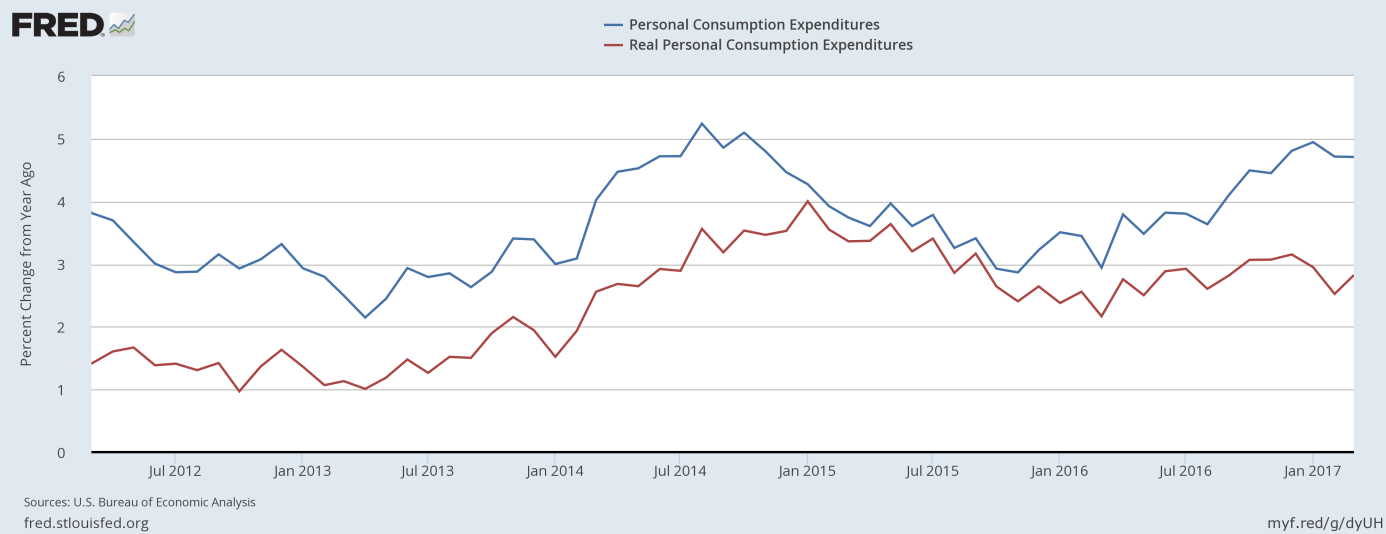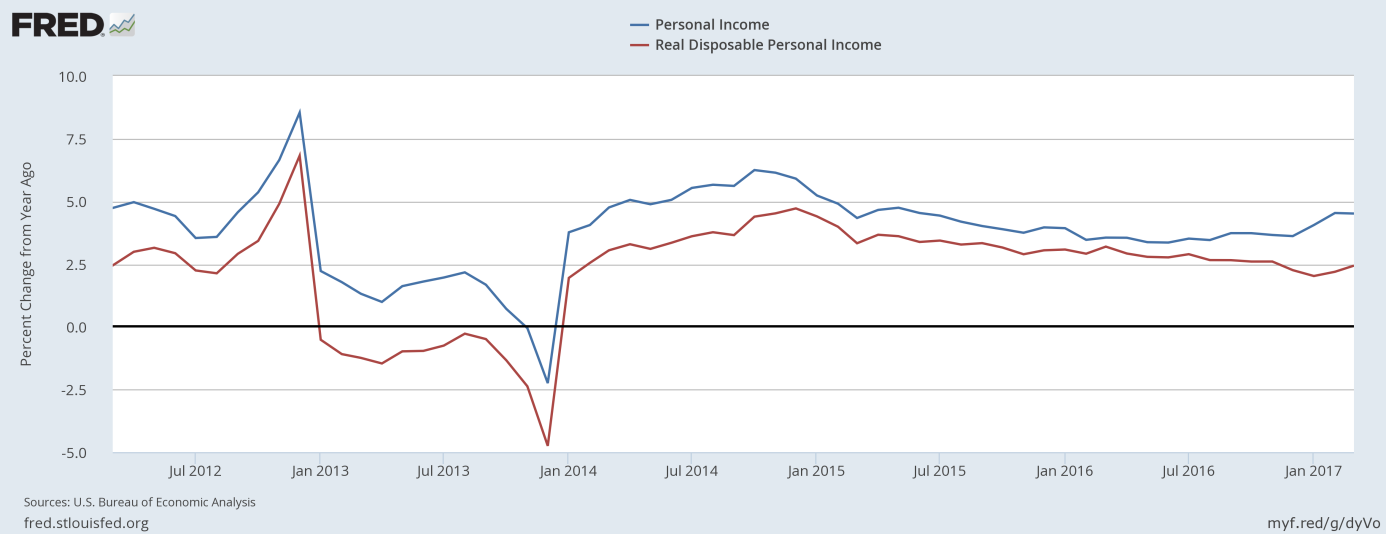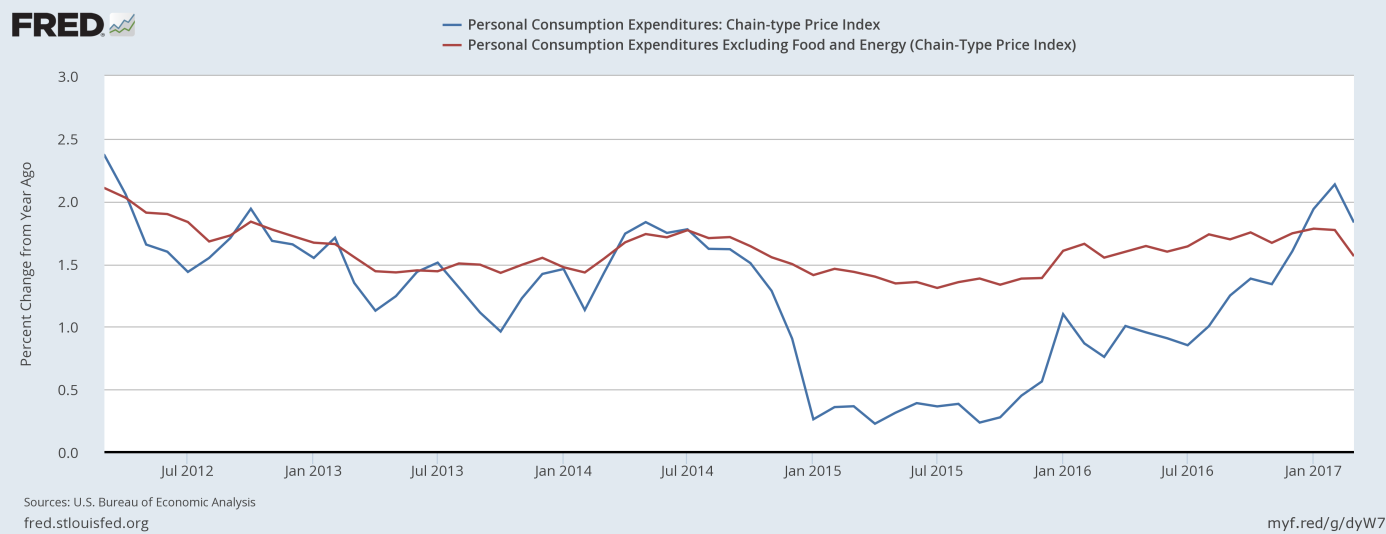U.S. consumer spending was flat in March. What does it imply for the gold market?
Personal consumption expenditures were unchanged in March, marking the second month of stagnation (after a downward revision from the previous 0.1-percent rise in February). The result is below consensus. On an annual basis, consumer spending rose 4.7 percent, slightly less than in the previous month, as one can see in the chart below. However, the pace of real personal consumption expenditures growth increased from 2.5 to 2.8 percent. It signals that the stagnation in personal outlays could be caused by lower oil and motor vehicles prices.
Chart 1: Nominal personal consumption expenditures (blue line) and real personal consumption expenditures (red line) from 2012 to 2017 (as percent change from year ago).

But soft consumer spending does not bode well for economic growth. Indeed, consumption growth was only 0.3 percent in the first quarter of 2017, the worst showing since no change in the fourth quarter of 2009. And the real GDP increased only 0.7 percent in Q1 2017 on annualized basis, lower than the 1.1-percent forecast. The slowdown in economic growth – if persistent – would be positive for the gold market.
The income side of the report was also disappointing, as personal income increased only 0.2 percent in March, following a 0.3 percent increase in the previous month (after revision). The rise in income was also below expectations. Importantly, the wages and salaries component rose only 0.1 percent. However, personal incomes seem solid on an annual basis, as one can see in the chart below.
Chart 2: Nominal personal income (blue line) and real disposable personal income (red line) over the last 5 years (as percent change from year ago).

The PCE price index declined 0.2 percent in March, after a 0.1-percent increase in the previous month, while its core version dropped 0.1 percent, after a 0.2-percent rise in February. On an annual basis, the core PCE price index excluding food and energy prices rose 1.6 percent, while the overall PCE price index jumped 1.8 percent. It means that inflation retreated from its five-year peak hit in February, as one can see in the chart below. Therefore, the weakened inflationary pressures could ease some pressure on the Fed to raise interest rates.
Chart 3: PCE Price Index (blue line) and Core PCE Price Index (red line) as percent change from year ago, from 2012 to 2017.

When it comes to other recent important data, the ISM Manufacturing Index slipped from 57.2 percent in March to 54.8 percent in April, while construction spending declined 0.2 percent in March, after a huge 1.8-percent gain in February. And new orders for U.S. durable goods jumped 0.7 percent in March, marking the third monthly gain in a row.
The bottom line is that the March personal income and outlays report was disappointing. Personal incomes rose just 0.1 percent, consumer spending was flat, and inflationary pressures softened. Hence, the recent U.S. economic data could support the camp of U.S. monetary policy doves, which might be good news for the price of gold. However, there were no expectations of a Fed hike tomorrow anyway, and there is still plenty of time before the June meeting – according to the market odds, the U.S. central bank is still on track to raise interest rates then. Hence, the impact of the recent economic data on gold should be limited. It seems that the price of gold has declined recently because of eased political uncertainty after the first round of the French presidential election and the averted U.S. government shutdown (thanks to a bipartisan agreement on a spending package). It may be a really hot week for the gold market, as the May FOMC statement on monetary policy will be released tomorrow, while April non-farm payrolls are due on Friday. Stay tuned!
If you enjoyed the above analysis, we invite you to check out our other services. We focus on fundamental analysis in our monthly Market Overview reports and we provide daily Gold & Silver Trading Alerts with clear buy and sell signals. If you’re not ready to subscribe yet and are not on our mailing list yet, we urge you to join our gold newsletter today. It’s free and if you don’t like it, you can easily unsubscribe.
Disclaimer: Please note that the aim of the above analysis is to discuss the likely long-term impact of the featured phenomenon on the price of gold and this analysis does not indicate (nor does it aim to do so) whether gold is likely to move higher or lower in the short- or medium term. In order to determine the latter, many additional factors need to be considered (i.e. sentiment, chart patterns, cycles, indicators, ratios, self-similar patterns and more) and we are taking them into account (and discussing the short- and medium-term outlook) in our trading alerts.
Thank you.
Arkadiusz Sieron
Sunshine Profits‘ Gold News Monitor and Market Overview Editor
Gold News Monitor
Gold Trading Alerts
Gold Market Overview


